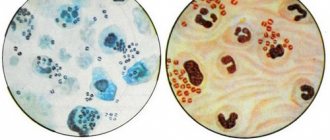Discharge from a man's penis is usually the first sign of a genitourinary tract infection. This problem cannot be ignored. Almost every man who is sexually active can become infected with sexually transmitted diseases, which may not appear immediately, but after several weeks. Many do not consider it necessary to use contraceptives during sexual intercourse or to observe basic rules of personal hygiene. In any case, if discharge occurs that creates discomfort, it is necessary to conduct a biochemical study of the released exudate.
Physiological secretions
- The criteria for normal urine are light golden color and absence of odors;
- the criteria for normal prostate secretion are viscous nature, white tint, a certain smell of sperm;
- the criterion for normal ejaculate is sperm mixed with the secretion secreted by the prostate, gray in color, and having the consistency of mucus;
- The criterion for normal smegma is a thick white lubricant.
Smegma (preputial lubricant) accumulates under the foreskin of the penis and is an accumulation of fats and the remains of some bacteria. Lubricant serves to reduce the sensation of friction between the head and the foreskin. At different periods of life, the amount of secretion secreted by the preputial glands is different, the peak occurs during puberty, and by old age it completely stops.
If hygiene rules are not followed, lubricant (smegma) collects under the foreskin. Fat oxidation occurs, and the proteins included in the composition begin to disintegrate. Simply put, the process of rotting begins. The color of the lubricant becomes greenish and a putrid odor appears. The constant accumulation of lubricant leads to chronic balanitis, or, even worse, malignant tumors develop.
The urethral glands secrete a colorless fluid called urethrorrhea. It serves to provide protection to the urethra. Its appearance is associated with strong arousal during erection. The volume of discharge depends on the physiological characteristics of each organism, but after a long period of abstinence from sex, the amount increases.
In the morning, wet dreams (spontaneous discharge of sperm) not related to sex are possible. Pollution is possible both in adolescents and in mature men who have not had sexual intercourse for a long time.
With strong tension in the abdominal muscles, a small amount of translucent mucus is released from the urethra. Prostatorrhea can also occur during constipation.
Reasons for discharge from the penis
The reasons can be completely different. They should be listed in more detail:
- venereal diseases cause abundant and frequent formations. At the same time, they are accompanied by painful sensations and burning. And the formations themselves have an unpleasant, pronounced putrefactive odor;
- Often, the flow of fluid from the genital organ is associated with neurotic disorders. This happens due to age in adolescents, with prolonged sexual abstinence, and so on. They do not threaten health and are a consequence of the human condition;
- damage to the organ can also cause fluid to leak. But it will not have a specific smell;
- the course may manifest itself as a secondary symptom of some diseases. For example, with prostatitis, the same symptoms may occur.
In any case, you should not figure it out on your own and find out the reason. The risk of making a mistake is too great.
Pathological changes in discharge
Pathological discharge from the penis may indicate sexually transmitted diseases (STDs), cancer, nonspecific inflammatory process or trauma to the genitals.
It is possible to distinguish from normal discharge those associated with a pathological nature by their character, smell, color:
- the volume of discharge has become much more abundant or, conversely, decreased;
- the color has changed, the discharge has become cloudy;
- admixtures of blood, pus, and lumps of mucus appeared;
- change in structure: discharge has become sticky and thick;
- the smell has become fishy, sour or putrid;
- There is discomfort when urinating.
If you notice any changes in the discharge, it is dangerous to self-medicate. It is necessary to consult a doctor as soon as possible, be sure to undergo tests, and also take a smear.
Pathological processes
Discharges associated with pathology are divided into several groups:
- Inflammations of various natures, including those associated with one’s own opportunistic microflora.
- Oncology.
- Sexually transmitted diseases.
- Surgical consequences or inflammation that developed against the background of mechanical injuries.
Often such processes are accompanied by purulent discharge associated with the penetration of infection. Due to the content of a large number of leukocytes, such liquid becomes thick, yellow or greenish in color.
As a rule, with such discharge, a diagnosis of trichomoniasis or gonococcus is made. In this case, the man experiences pain in the penis, pain, burning or itching. For oncology of the prostate, genital organs, bladder, etc. The discharge may be brown with or without mucus and may contain pus or blood clots.
Discharge characteristic of STDs
Discharges that become very viscous and have a transparent color, as a rule, are a chronic form of mycoplasmosis and ureaplasmosis, chlamydia. During the analysis, leukocytes are found in the field of view up to 5 units.
If the discharge becomes white and translucent, this indicates the presence of an acute form of mycoplasmosis, chlamydia, or ureaplasmosis.
Discharge with purulent patches and a characteristic odor is a sign of gonorrhea. Their structure is very thick and sticky, the color is greenish-yellow. Laboratory tests reveal a large number of leukocytes. There is also pain when urinating.
With STDs, infections consisting of several pathogens are often encountered. The symptoms and nature of the discharge take on a completely different look, so it is very important to conduct high-quality laboratory tests to identify the true causative agents of the disease.
Non-venereal inflammation and discharge in men
Non-venereal inflammation occurs when a nonspecific bacteria enters the pelvic organs, and can also be a consequence of problems with the immune system. One's own microflora becomes opportunistic when pathogenic bacteria, found in small quantities, begin to prevail over beneficial bacteria, thereby causing non-venereal inflammation.
Nongonorrheal urethritis is characterized by discharge in the form of purulent lumps in small quantities. There is a frequent urge to urinate and a feeling of itching. Infection has an ascending nature, infecting first the bladder, then the kidneys. When a kidney infection occurs, the discharge contains an admixture of blood. This is a very dangerous symptom.
Fungi of the genus Candida cause candidiasis. An increase in the number of these fungi occurs when one’s own immunity is weakened, as well as after taking antibiotics. Symptoms include discharge that resembles cottage cheese in its structure. There is a sour odor and itching sensation, especially when urinating.
Gardnerellosis of the urethra is determined by a specific fishy odor; the discharge becomes yellow-green in color and is of small volume. This infection occurs when there is a disturbance in the microflora, in other words, when dysbacteriosis appears.
If the foreskin becomes inflamed (balanoposthitis), the discharge becomes purulent and contains mucus. The head of the penis becomes red and very painful.
Prostatitis manifests itself as cloudy discharge that appears at the end of urination. This disease has serious complications, such as lack of erection and complete impotence, anuria.
What could be the consequences?
If left untreated, diseases that are accompanied by the discharge of pus can become chronic and lead to serious complications. The most dangerous is infertility and the development of cancer. Among others, we can note, in particular, inflammation of the prostate gland, testicle, narrowing of the urethra, damage to the joints, nervous system and others.
If you do not pay attention to alarming symptoms, the consequences can be severe. Most often, patients encounter problems such as suppuration in the genitourinary organs and the spread of infection to other systems of the body.
To avoid disability (which, by the way, often happens among careless carriers of sexually transmitted diseases), you must consult a doctor immediately after the appearance of suspicious symptoms.
Discharge uncharacteristic of inflammation
Spermatorea is the passive leakage of sperm, without masturbation or sexual intercourse. This disease is most often a consequence of stress, neurosis or diseases of the spine. With spermatorrhea, innervation of the ducts occurs.
Bloody discharge may appear after trauma to the urethral canal, taking a smear, installing a catheter, or when sand or small stones pass through the urethral canal. In this case, hematorrhea is very painful.
A serious symptom is brown discharge with pus and blood - they indicate the presence of a malignant tumor.
If you discover any uncharacteristic discharge, you should immediately contact a medical facility and undergo the necessary tests. The sooner the correct diagnosis is made, the sooner recovery will occur.
Other sexually transmitted pathologies
Trichomoniasis and gonorrhea can also manifest themselves as colorless discharge from the urethra. They usually have a yellow or green tint, the smell of rotten fish or other unpleasant aroma, and a thick, runny consistency. In addition, you may notice the following symptoms:
- Burning, pain, itching during urination and after sexual intercourse;
- Increased body temperature;
- Swelling of the head of the penis;
- Redness in the area of the urethral opening.
- Discharge with gonorrhea has a green tint, with trichomoniasis it is yellow, sometimes mixed with blood, which indicates severe damage.
To diagnose sexually transmitted pathologies, a smear is taken from the urethra for microscopic examination. Additionally, the blood is checked for the presence of syphilis and other diseases. Treatment is carried out with antibiotics, sometimes broad-spectrum drugs. Or they do a tank culture to determine sensitivity to a group of antibacterial agents.
Sometimes a paired combination of urethral infections is diagnosed, for example, gonorrhea and chlamydia. This complicates treatment and gives an unclear clinical picture.
How is the examination carried out?
- First of all, the penis is examined. The procedure is necessary to identify traces of injuries to the head and foreskin. You should pay attention to whether there is a rash or discharge.
- Mandatory examination and palpation of the lymph nodes in the groin, determining their size, condition, temperature.
- Collecting secretions from the prostate for laboratory testing - for this purpose, massage of the prostate is performed through the rectum.
In the laboratory, the collected material is examined under a microscope:
- A smear can determine the maturity of leukocytes and their number in the field of view. An increased amount indicates acute urethritis or a chronic inflammatory process;
- an increased number of eosinophils indicates an allergic process in the urethra;
- when red blood cells are detected, we can talk about tumors and serious inflammation;
- if the amount of epithelium exceeds the norm, then we are talking about chronic urethritis;
- there is sperm in the smear - spermatorrhea;
- mucus was found in the smear - urethrorrhea;
- lipid grains are present in the smear - prostatorrhea.
For reliable results, you must follow some rules: do not wash yourself before taking the material, do not have sex a day before the test, do not go to the toilet several hours before taking a smear.
LHC culture is needed to identify the largest number of microorganisms belonging to the same species. Their properties are being studied for further diagnosis of infection. A general blood and urine test is taken. An ultrasound examination of the pelvic organs and prostate is carried out, and if necessary according to indications, then tomography.
Any uncharacteristic discharge is a serious reason to consult a doctor. You cannot self-medicate, even if the disease seems obvious to you. In this way, you can develop complications that are difficult to treat even with the strongest antibiotics. The inflammatory process will not stop, but will only acquire a latent form, which is fraught with serious complications, including death.











